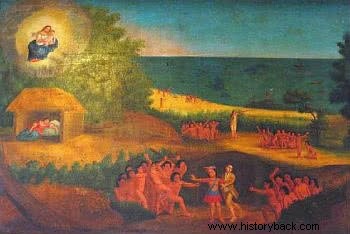Diogo Álvares Correia, known as Caramuru , was one of the first Portuguese to settle in Bahia.
He is considered the “biological father” of Brazil due to his marriage to an Indian from the Tupinambá tribe called Paraguaçu.
Biography
As the sources about his life are few, much of what is known about Caramuru is based on the writings of Gabriel Soares de Souza, who was a plantation owner in Bahia in 1569. Another more detailed account is told by the Jesuit Simão de Vasconcellos, provincial and rector of schools in Bahia and Rio de Janeiro.
Diogo Álvares Correia was born in Viana de Castelo, Portugal, and would have docked in Bahia between 1509 and 1510. It is not known for sure whether he arrived as a shipwrecked person or was left on purpose by the captain of the ship in order to learn the customs and languages of the natives.
This method was used by the Portuguese on the African coast with the intention that the individual could serve as a bridge between the Portuguese and the local inhabitants.
There are even historians who maintain that Caramuru would have come aboard a French ship, as he also helped the French to trade with the Indians of that region.
Gabriel Soares de Souza tells that Diogo Álvares Correia only escaped being killed by the indigenous people because he fired a gun and killed a bird. The Indians who did not know gunpowder were surprised by the explosion and began to call him “Caramuru” or son of fire.
On the other hand, Diogo is said to have had his clothes soaked and covered in sargassum glued to his body due to the shipwreck.
The Indians nickname it “Caramuru” which means moray eel, a jelly-like fish that lives among the reefs by the sea.
Caramuru and Paraguaçu
The life of the Portuguese would take a new turn when he fell in love with Paraguaçu, the daughter of the chief Taparica, of the Tupinambá tribe. In some chronicles it is mentioned that she was the one who saved Caramuru from being devoured by the tribe.
The couple would travel to France in 1528, where she would be baptized in the church of Saint-Malo. India would adopt the name Catarina do Brasil or Catarina des Granges, in honor of her godmother Catherine des Granges, wife of Jacques Cartier, the explorer of Canada. The couple also got married in this French city.
After this trip, Caramuru made contact with the King of Portugal in order to provide caravels with men, animals and weapons to colonize Bahia. This expedition would be led by Tomé de Souza who would arrive in 1549.

In the foreground, Paraguaçu saves Caramuru from the indigenous people. In the background, Caramuru shoots a firearm scaring the natives.
First Family in Brazil
Caramuru and Paraguaçu formed the first Catholic family in Brazil. In this way, the daughters could be baptized and therefore registered.
The couple had four daughters:Geneva, Apolônia, Graça and Madalena. They married newly arrived Portuguese nobles and thus formed the first Bahian and Brazilian families. It is estimated that their descendants may reach 50 million Brazilians. Caramuru also had 16 children with other indigenous people.
He died on October 5, 1557 in the city of Tatuapara, Bahia.
Curiosities
- The name "Paraguaçu" was a 17th century creation. Probably Catarina's indigenous name would be Guaibimpará.
- The Indian Moema, who would have thrown herself into the sea chasing Caramuru, may have been a character invented by Frei de Santa Rita Durão, author of the poem “Caramuru”, from 1781.
Films and Documentaries
- Caramuru - the invention of Brazil . Directed by:Guel Arraes. 2001.
- From there to here:Caramuru . 2009.
